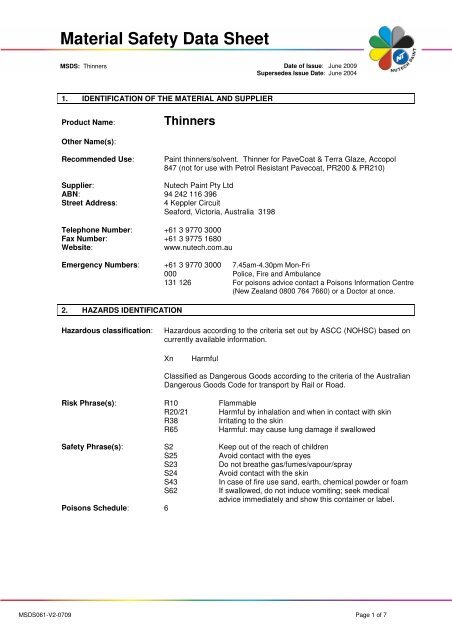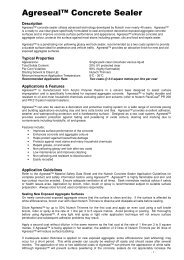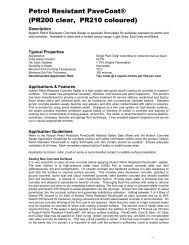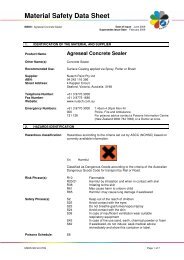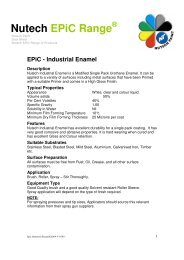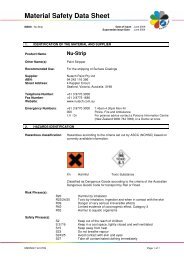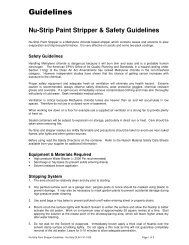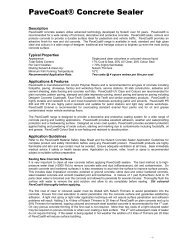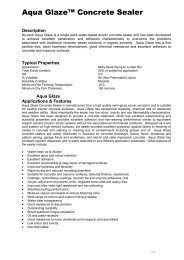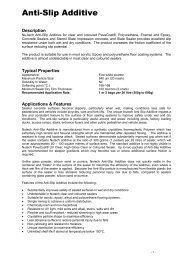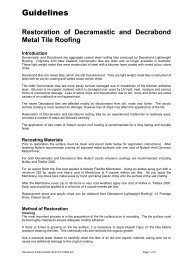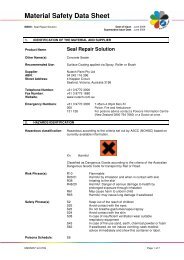Nutech Thinners MSDS
Nutech Thinners MSDS
Nutech Thinners MSDS
You also want an ePaper? Increase the reach of your titles
YUMPU automatically turns print PDFs into web optimized ePapers that Google loves.
Material Safety Data Sheet<br />
<strong>MSDS</strong>: <strong>Thinners</strong><br />
1. IDENTIFICATION OF THE MATERIAL AND SUPPLIER<br />
Product Name: <strong>Thinners</strong><br />
Other Name(s):<br />
Date of Issue: June 2009<br />
Supersedes Issue Date: June 2004<br />
Recommended Use: Paint thinners/solvent. Thinner for PaveCoat & Terra Glaze, Accopol<br />
847 (not for use with Petrol Resistant Pavecoat, PR200 & PR210)<br />
Supplier: <strong>Nutech</strong> Paint Pty Ltd<br />
ABN: 94 242 116 396<br />
Street Address: 4 Keppler Circuit<br />
Seaford, Victoria, Australia 3198<br />
Telephone Number: +61 3 9770 3000<br />
Fax Number: +61 3 9775 1680<br />
Website: www.nutech.com.au<br />
Emergency Numbers: +61 3 9770 3000 7.45am-4.30pm Mon-Fri<br />
000 Police, Fire and Ambulance<br />
131 126 For poisons advice contact a Poisons Information Centre<br />
(New Zealand 0800 764 7660) or a Doctor at once.<br />
2. HAZARDS IDENTIFICATION<br />
Hazardous classification: Hazardous according to the criteria set out by ASCC (NOHSC) based on<br />
currently available information.<br />
Xn Harmful<br />
Classified as Dangerous Goods according to the criteria of the Australian<br />
Dangerous Goods Code for transport by Rail or Road.<br />
Risk Phrase(s): R10 Flammable<br />
R20/21 Harmful by inhalation and when in contact with skin<br />
R38 Irritating to the skin<br />
R65 Harmful: may cause lung damage if swallowed<br />
Safety Phrase(s): S2 Keep out of the reach of children<br />
S25 Avoid contact with the eyes<br />
S23 Do not breathe gas/fumes/vapour/spray<br />
S24 Avoid contact with the skin<br />
S43 In case of fire use sand, earth, chemical powder or foam<br />
S62 If swallowed, do not induce vomiting; seek medical<br />
advice immediately and show this container or label.<br />
Poisons Schedule: 6<br />
<strong>MSDS</strong>061-V2-0709 Page 1 of 7
Material Safety Data Sheet<br />
<strong>MSDS</strong>: <strong>Thinners</strong><br />
3. COMPOSITION / INFORMATION ON INGREDIENTS<br />
Date of Issue: June 2009<br />
Supersedes Issue Date: June 2004<br />
Substance CAS# Proportion % Risk Phrase(s)<br />
Xylenes 1330-20-7 > 60 R10 R20/21 R38<br />
Liquid Hydrocarbons 64742-95-6 30 - 60 R65<br />
4. FIRST AID MEASURES<br />
Swallowed If swallowed do not induce vomiting. Rinse the mouth out with water and give a<br />
glass of water. Seek medical attention immediately.<br />
Eye Immediately open eye and flush with plenty of running water for at least<br />
15 minutes. Seek medical attention.<br />
Skin Remove contaminated clothing and wash affected area with plenty of soap and<br />
water. If irritation, swelling or blistering occurs seek medical attention<br />
immediately.<br />
Inhalation Remove victim to fresh air, remove any contaminated clothing to prevent further<br />
exposure. Keep victim warm. If symptoms persist seek medical attention.<br />
Medical Advice Treat symptomatically. The Poisons Information Centre can be contacted on 131<br />
126 for advice or contact your local doctor or hospital.<br />
5. FIRE FIGHTING MEASURES<br />
Suitable Extinguishing Media: Fire fighting Foam, Carbon Dioxide or Dry Chemical Powder.<br />
Hazards from Combustion Products:<br />
Special Protective precautions<br />
and equipment for Fire fighters:<br />
Hazchem Code 3[Y]<br />
6. ACCIDENTAL RELEASE MEASURES<br />
Flammable Liquid. When burning the product will emit toxic<br />
fumes mostly comprised of Oxides or Carbon (Carbon<br />
Monoxide and Carbon Dioxide).<br />
Self contained breathing apparatus should be worn to protect<br />
the fire fighter against potential toxic fumes that may be<br />
present. Containers should be kept cool with water spray and<br />
if safe to do so, containers should be removed from the path<br />
of the fire.<br />
Emergency Procedures: If the waterways or sewers become contaminated with<br />
product advise the local authorities about the contamination.<br />
Methods and Materials for<br />
containment and clean up:<br />
All ignition sources should be shut down or removed and<br />
unprotected personnel removed from the area. Protective<br />
equipment should be worn with care being taken, as spill area<br />
will be slippery.<br />
<strong>MSDS</strong>061-V2-0709 Page 2 of 7
Material Safety Data Sheet<br />
<strong>MSDS</strong>: <strong>Thinners</strong><br />
7. HANDLING AND STORAGE<br />
Date of Issue: June 2009<br />
Supersedes Issue Date: June 2004<br />
Do not contaminate the waterways or sewer with spill. Do not<br />
flush into drains and sewer. If sewer or waterway becomes<br />
contaminated contact the local authority. Dike and contain<br />
spill with sand, earth or an absorbent material. Clean up<br />
before material dries. Place collected material in an<br />
appropriate container and dispose of material in accordance<br />
with the local authority.<br />
Precautions for Safe Handling: Keep out of the reach of children.<br />
Avoid contact with eyes or mouth and avoid repeated<br />
prolonged contact with skin.<br />
Conditions for Safe Storage: Store in a cool dry place out of direct sunlight, away from<br />
ignition sources and not stored near oxidising materials.<br />
8. PERSONAL PROTECTION / EXPOSURE CONTROL<br />
Protective Equipment:<br />
Personal:<br />
Containers should be sealed when not in use and should be<br />
checked on a regular basis for signs of damage or leaks.<br />
Wear Overalls that cover the legs and arms.<br />
Gloves: Long Chemical Resistant PVC Gloves.<br />
Eyes: Chemical goggles resistant to hydrocarbon solvents.<br />
Respiratory: Brush or Roller application: Type A, Class 1 Organic Vapour<br />
to AS1715 (e.g. 3M Easicare 5101/5201/5301, Type 1A).<br />
Spray Application: As above in conjunction with Class P1<br />
particle filter.<br />
Other: Practice strict hygiene – wash hands before breaks and after<br />
finishing.<br />
National Exposure Limits: Xylene(s) TWA 80 ppm 350 mg/m 3<br />
STEL 150 ppm 655 mg/m 3<br />
Ethyl Benzene TWA 100 ppm 434 mg/m 3<br />
STEL 125 ppm 543 mg/m 3<br />
Mineral Turps TWA 41 ppm 200 mg/m 3<br />
<strong>MSDS</strong>061-V2-0709 Page 3 of 7
Material Safety Data Sheet<br />
<strong>MSDS</strong>: <strong>Thinners</strong><br />
Date of Issue: June 2009<br />
Supersedes Issue Date: June 2004<br />
Biological Limit Value:<br />
Xylene Methylhippuric acids in urine End Shift 1.5g/g ACGIH<br />
2003<br />
Ethyl Benzene Mandelic Acid in urine End Work Week 1.5g/g<br />
ACGIH<br />
Engineering Controls: Avoid heating of the product or containers it is contained in.<br />
Ensure that adequate ventilation is provided to ensure that<br />
exposure is kept to a minimum and below the occupational<br />
health hazard recommendations. Avoid entering confined<br />
areas where vapour may have been collecting keeping in<br />
mind that the vapour is heavier than air and will settle into<br />
hollows.<br />
9. PHYSICAL AND CHEMICAL PROPERTIES<br />
Property Units Result<br />
Appearance Clear water white liquid<br />
Colour Colourless to slight yellow colour<br />
Odour Distinct Aromatic Hydrocarbon odour<br />
pH N/A<br />
Vapour Pressure KPa 4.5<br />
Vapour Density 3.7<br />
Boiling Point/Range<br />
o<br />
C 136-191<br />
Freezing Point<br />
10. STABILITY AND REACTIVITY<br />
o C -48<br />
Solubility in Solvent 100%<br />
Solubility in Water 0.175 grams per Litre<br />
Specific Gravity Kg/Lt 0.853<br />
Flash Point<br />
o<br />
C 21-31<br />
Upper Explosion Limit % 1.0<br />
Lower Flammability Limit<br />
Auto Ignition Temperature<br />
%<br />
o<br />
C<br />
7.1<br />
432-530<br />
Volatile Organic Content % 100<br />
Evaporation Rate 13.5<br />
Viscosity Cps 0.9<br />
Chemical Stability: Stable under normal use conditions.<br />
Conditions to Avoid: Avoid repeated contact with person, contact<br />
with food and high temperature conditions with<br />
sealed containers.<br />
Incompatible Materials: Incompatible with oxidising agents, acids,<br />
combustible materials and sources of ignition<br />
Hazardous Decomposition Products: Thermal decomposition is highly dependent on<br />
conditions. A complex mixture of airborne<br />
solids, liquids and gases, including carbon<br />
monoxide, carbon dioxide and other organic<br />
compounds will be evolved when this material<br />
undergoes combustion or thermal or oxidative<br />
degradation.<br />
Hazardous Reactions: Reacts violently with strong oxidizing agents.<br />
<strong>MSDS</strong>061-V2-0709 Page 4 of 7
Material Safety Data Sheet<br />
<strong>MSDS</strong>: <strong>Thinners</strong><br />
11. TOXICOLOGICAL INFORMATION<br />
Date of Issue: June 2009<br />
Supersedes Issue Date: June 2004<br />
If used in accordance with the manufacturers recommendations and this Material Safety Data Sheet no<br />
negative health results should occur. If exposure results in symptoms, the following may be observed:<br />
Acute and Chronic Exposure and Routes of Exposure<br />
Acute: High vapour concentrations are irritating to the eyes and respiratory tract,<br />
may cause headaches, dizziness and may have a depressive effect on the<br />
central nervous system.<br />
Chronic: Prolonged exposure or repeated contact with the skin can irritate and<br />
cause dermatitis.<br />
Routes of exposure<br />
General: If swallowed nausea, vomiting and depression of the central<br />
nervous system can occur.<br />
Eyes: May be irritating to the eye.<br />
Respiratory System: Inhalation of the product can produce an irritating effect to the<br />
mucous membrane of the respiratory tract. Headache, nausea,<br />
loss of balance and drowsiness is common when excess<br />
inhalation occurs. Central nervous depression can also occur<br />
with excess inhalation, which may lead to unconsciousness.<br />
Skin: If contact with the skin is made a degreasing effect will be<br />
witnessed and will be likely to cause irritation of the skin.<br />
Repeated contact can lead to conditions such as dermatitis in<br />
the contact area. Absorption of some of the product<br />
components may occur and produce the relevant toxic effects.<br />
Long Term Effects: No information is available on this product at present other than<br />
repeated contact might cause dermatitis.<br />
Toxicological Information:<br />
Toxicological Information for<br />
Product Components:<br />
Xylene<br />
Oral LD50 Rats > 200 mg/Kg, LD50 Rabbits > 2000<br />
mg/Kg<br />
Inhale LC50 Rat 4hr > 20mg/L<br />
<strong>MSDS</strong>061-V2-0709 Page 5 of 7
Material Safety Data Sheet<br />
<strong>MSDS</strong>: <strong>Thinners</strong><br />
12. ECOLOGICAL INFORMATION<br />
Date of Issue: June 2009<br />
Supersedes Issue Date: June 2004<br />
Ecotoxicity: Avoid contaminating the sewer system and waterways.<br />
Acute Toxicity<br />
Fish : Toxic: 1 < LC/EC/IC50
Material Safety Data Sheet<br />
<strong>MSDS</strong>: <strong>Thinners</strong><br />
• Class 1 Explosives<br />
• Class 2.1 Flammable Gases<br />
• Class 2.3 Poisonous Gases<br />
NUTECH PAINT PTY LTD<br />
Date of Issue: June 2009<br />
Supersedes Issue Date: June 2004<br />
• Class 4.2 Spontaneously Combustible Substances<br />
• Class 5.1 Oxidising Agents<br />
• Class 5.2 Organic Peroxides<br />
• Class 7 Radioactive Substances<br />
15. REGULATORY INFORMATION<br />
Hazard Status: This product is hazardous according to criteria set out by the ASCC<br />
Poisons Schedule: 6<br />
Xn Harmful<br />
Risk Phrase(s): R10 Flammable<br />
R20/21 Harmful by inhalation and when in contact with skin<br />
R38 Irritating to the skin<br />
R65 Harmful: may cause lung damage if swallowed<br />
Safety Phrase(s): S2 Keep out of the reach of children<br />
S25 Avoid contact with the eyes<br />
S23 Do not breathe gas/fumes/vapour/spray<br />
S24 Avoid contact with the skin<br />
S43 In case of fire use sand, earth, chemical powder or foam<br />
S62 If swallowed, do not induce vomiting; seek medical<br />
advice immediately and show this container or label.<br />
AICS: All materials contained in this product appear in the AICS (Australian<br />
Inventory of Chemical Substances) database.<br />
16. OTHER INFORMATION<br />
<strong>Nutech</strong> Paint Pty Ltd has prepared this Material Safety Data Sheet.<br />
4 Keppler Circuit Seaford Victoria Australia 3198 Page 7 of 7<br />
Tel: +61 3 9770 3000 Fax: +61 3 9775 1680<br />
Website: www.nutech.com.au Email: sales@nutech.com.au<br />
NUTECH PAINT THOMASTOWN 216 Settlement Road Thomastown Victoria Australia 3074 Tel: +61 3 9465 5111 Fax: +61 3 9465 5222<br />
NUTECH PAINT SYDNEY 18 South Street Rydalmere NSW Australia 2116 Tel: +61 2 9638 7089 Fax: +61 2 9638 7911<br />
NUTECH PAINT BRISBANE Unit 2 14-16 Loganlea Road Waterford QLD Australia 4133 Tel: +61 7 3805 7455 Fax: +61 7 3805 2677<br />
NUTECH PAINT WESTERN AUSTRALIA 1/43 Felspar Street Welshpool WA Australia 6106 Tel: +61 8 9458 2111 Fax: +61 8 9451 6004<br />
NUTECH PAINT UK Tel: +44 (0)141 945 2005


